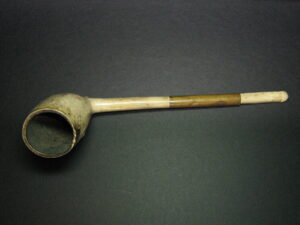On display at the Kelley House Museum’s current exhibit are several clay pipes. Most are incomplete – missing a stem or the bowl – but are nonetheless intriguing – as are the old glass bottles and other remnants of an earlier times that we have dug out of our archives for this show, “Neighbors Across The Pond.”

A white clay smoking pipe with copper banding on the handle. Stamped on the pipe bowl are the words, “W. White Glasgow,” which indicates that the pipe was made by the William White Co. in Glasgow, Scotland. Donated to the Museum by Randy Fletcher, the pipe was given to him by Zella Hall. It belonged to her great-great grandfather, who was a ship captain in the 1850s. (Object ID# 2007-13-001)
The joys of smoking were introduced to Europeans by Native Americans in the 1500s, and when Sir Francis Drake returned to England with tobacco, the famous man started a craze for smoking and its paraphernalia.
Pipes were used by women and even children in the earliest decades of their introduction. The smell of tobacco would have disguised the stench of the streets in large cities that had primitive sewage systems. At one time smoking was encouraged to ward off The Plague.
The kind of clay pipes used in those earlier times, and that we’re showing, are still made and enjoyed today. Smokers especially appreciate them because their clean, neutral, ceramic material does not compete with the flavors of specialty tobaccos.
Most, but not all, of the pipes from our collection came from the bottom of the Kelley Pond. They have an integral stem, with the pipe bowl and the long stem manufactured as a single piece, making for a simple and graceful object. Formed in two-part molds using finely ground white clay, they were incredibly cheap to make and essentially disposable. Their stems broke easily. At the time when the fashion was to have stems as long as a yard, if the stem broke, one could continue to use the pipe until another break or two occurred, and your nose hair started to burn.
Through research, we know that the majority of our pipes were made by a firm named “McDougall” in “Glasgow.” These two words were stamped into opposing sides of the pipe stems at the time of their manufacture. We also know that McDougall began making pipes in 1846. It is very unlikely that a clay pipe would have found its way to Mendocino and the depths of the Kelley House pond until after William Kelley constructed it, providing us with a date of circa 1880 for their earliest arrival.
Other pipe bowls in the collection are stamped with the initials “TD.” First manufactured in England in the 18th century by Thomas Dormer and possibly his son, TD pipes were widely copied by pipe makers throughout the 19th century.
Glasgow-made pipes have traveled the world, and have been reported by archaeologists in Australia, Jamaica, Easter Island, and Canada. They dominated the market in the latter half of the 19th century. Mendocino can join the ranks of locations around the globe where these pipes were smoked, broken, and tossed out of sight and out of mind.
Come see the clay pipes, the Frozen Charlottes, and other curious items at the Kelley House Museum, open Thursdays through Sunday, 11am to 3pm. Our historic walking tours may be booked online at kelleyhousemuseum.org. Call us at (707) 937-5791 or contact info@kelleyhousemuseum.org